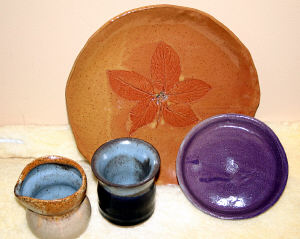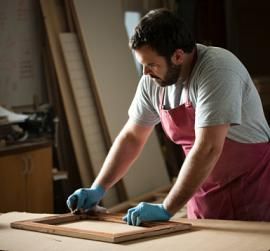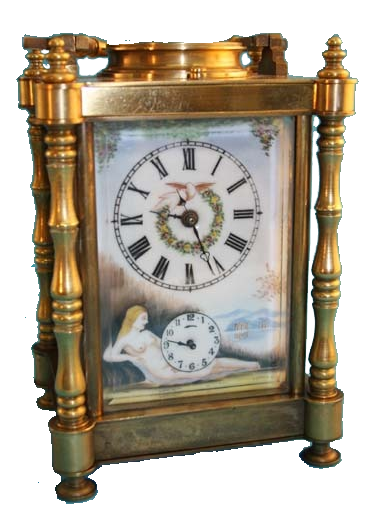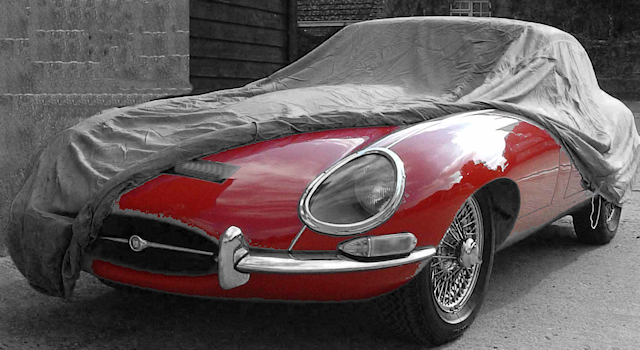Most people don’t know what the difference between ceramics and pottery. Pottery is anything that is thrown, hand built or sculpted.
Ceramics are made with a two piece mold. Clay slip is poured into a plaster mold, let for fifteen or twenty minutes, excess is poured out, then mold is set upside down and left for four hours or until piece can easily be lifted out without being distorted when mold is opened. Both pottery and ceramics are called bisque when fired.
Ceramics and pottery are general terms for wares or utensils made with clay.
Earthenware is a type of clay.
Earthenware is a clay that is kiln fired at low temperatures where it does not become vitreous. Glazes are usually very bright colored and if the glazes are properly chosen, earthenware can be quite strong and useful if glazed inside and out. Earthenware can be used in conventional and microwave ovens.
Washing by hand is recommended.
Glazes
Glazes are painted onto to greenware that, after kiln firing, they seal and color their surface. There are many compounds used to make glazes, such as silicates, aluminates, oxides, tin, sodium, potassium, lead, iron, copper and many more.
The recipes made from such compounds usually take into consideration what the utensils intended use is, matching thermal expansion properties between the clay and the glaze ingredients for longer useful life and color.
A bunch of factors, both natural and controllable ones, can alter a glaze suitability and behavior.
Unglazed Spots
Unglazed spots are common to all ceramics and pottery and are found in areas that do not affect the usability of the pottery. The foot of a pot or bowl is the area that rests on the surface or shelf of the kiln and is normally unglazed, because otherwise the glaze would bond to the kiln shelf during the firing process. It is not uncommon for imported ceramics or pottery to be dry footed.
By using this method it reduces the cost of producing the pottery and ceramics, more items can be placed in the kiln and it takes less time to complete the piece.
An unglazed foot or dry foot piece will absorb water from washing and can leave a water ring when placed on furniture if not completely dry.
In time the glaze will possibly flake, peel or even crack and when it does, it is not fit for food or beverages.
The most expensive pottery and ceramics sit on the points of little stands called stilts in a kiln, so that more of the surface will be covered with glaze.
The spots, called stilt marks, are evident if you look closely or run your hand along the bottom.
By using stilts your piece is completely waterproof which is most desirable.
Even though this method is more expensive it is worth the small difference in price.
Unglazed spots or bubbles can sometimes appear in other areas of the pottery or ceramic, caused by improper glazing, grease or oil on the earthenware or by gas bubbles coming out of under fired clay.
Ceramics with such unglazed spots should be avoided for food contact, as the spots can harbor colonies of bacteria.
Crazing
Crazes are small cracks in the glazing of pottery and ceramics.
They are caused by many things, such as a different thermal expansion rate between the glaze and the clay, glaze ingredients, too fast of a cooling rate and the firing process.
Whenever possible, crazed pottery and ceramics should be generally avoided for food contact, as the cracks can harbor colonies of bacteria, but using a bit of chlorine bleach or lemon to clean the cracks will help to rid the piece of bacteria.
Specks
Usually found on stoneware and ceramic earthenware pottery, dark specks in the glaze can be iron or other minerals that are permanent parts of the clay.
This is normal and will not usually affect the usability or longevity of the pottery.
Use And Care
Caring for pottery and ceramics is easy.
The glazes that cover the clay, protect it from discoloration.
Glazes that are approved for use with food do not react with acidic foods and can be used to store any food safely.
Earthenware pottery and ceramics can easily take the temperature and harsh detergents of a dishwasher and it is recommend washing all pieces by hand, especially to prevent accidental damage from other utensils beating against them in the dishwasher.
Health Concerns
There are no known adverse health effects from using unglazed clay in cooking.
Glazed clay products produced and imported into the US and Canada are deemed safe through a series of tests that manufacturers and importers are required to submit to the government, proving the quantities of cadmium and lead to be within acceptable levels.
Beware of pottery and ceramic cooking or tableware products you bring in or purchase from other countries, it is better to use them as flower pots instead.
Lead In Ceramics
Lead can be found all around us in dishes, fine crystal, painted walls, woodwork, toys, furniture, antique varnishes, solder, dust and soil.
The effects of lead poisoning are cumulative throughout our lifetime, therefore it is important to limit our exposure to it.
In the pottery and ceramic industry, some lead glazes are still used to color, decorate or smooth the surface of pottery and ceramic products.
As long as the clay and glazes are compatible and these glazes are properly fired at a high enough temperature and for an appropriate amount of time, the lead is not likely to leach through the surface.
With constant use and scrubbing, pottery and ceramic products can wear down over time and may allow lead to leach through.
Hot and highly acidic foods and prolonged time of contact, will increase lead leaching from such damaged surfaces.
Antique, highly decorated pottery and ceramics are the most likely to leach lead.
You might be able to visually detect lead leaching if pottery and ceramic items show a dusty or chalky gray residue on the glaze after they are washed.
When testing for lead content, be sure to test the surface that comes in contact with the food.
Terracotta refers to a type of earthenware that contains red burning clay.
Majolica is terracotta with an opaque white glaze, usually decorated with a colored overglaze and is stronger than terra cotta.




















